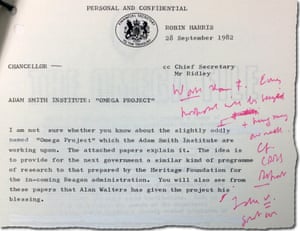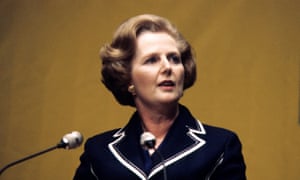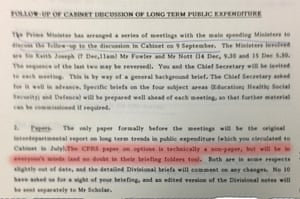Margaret Thatcher secretly tried to press ahead with a politically toxic plan to dismantle the welfare state even after a “cabinet riot” and her famous declaration that the “NHS is safe with us”, newly released Treasury documents show.
The plan commissioned by Thatcher and her chancellor Sir Geoffrey Howe included proposals to charge for state schooling, introduce compulsory private health insurance and a system of private medical facilities that “would, of course, mean the end of the National Health Service”.
Some of her cabinet ministers believed they had buried the plan, drawn up by a seconded Treasury official, Alan Bailey, from the Central Policy Review Staff (CPRS), at a special cabinet meeting on 9 September 1982.
Nigel Lawson in his memoirs said the paper of “long-term public spending options” had been buried after what he described as “the nearest thing to a cabinet riot in the history of the Thatcher administration”. In her own memoirs, Thatcher claimed to have been “horrified” by the CPRS paper and insisted that she and her ministers had never seriously considered it.
The CPRS paper had been partially leaked and she was only able to quell the subsequent furore by famously pledging the “NHS is safe with us” at the October 1982 Tory party conference. Downing Street briefed that the toxic plan had been “shelved”.

But Howe’s Treasury private office papers released by the National Archives on Friday confirm that not only had that special cabinet meeting taken place to discuss the plan but that two months later, far from being buried, Thatcher was still secretly trying to press ahead with it.
The Treasury papers show that once a clutch of tricky byelections were out of the way she was keen to keep pushing the plan and held a series of meetings in December to “to soften up the big three spenders” under her chairmanship “to resolve any immediate political anxieties”.
The papers also show after the 9 September cabinet showdown Howe rejected an approach from the Adam Smith Institute, the rightwing libertarian thinktank, to back their “slightly oddly-named Omega Project” despite it being personally endorsed by Thatcher’s own economic adviser, Sir Alan Walters.
The Omega Project papers said the plans were modelled on research by a rightwing US thinktank for the incoming Ronald Reagan administration. It also argued for many state services to be replaced by “more efficient alternatives from the private sector”.

Howe rejected the approach in a note on 29 September not because he objected to their proposals to dismantle the welfare state but because he feared its “ill-researched proposals, which will be portrayed as strongly resembling our own, might prove an embarrassment”. The then chancellor added: “Every proposal will be seized on and hung (round) our necks. Cf CPRS Report. I see v. (underlined twice) great harm.”
The Treasury papers show that “no real action” was taken on the CPRS “radical right manifesto” until November 1982. “The prime minister (we understand privately) did not want to stir this up before the cabinet discussions on the 1982 survey, nor risk any adverse publicity while the last two byelections were pending. The leaks of the CPRS report did not help,” a senior Treasury official, Peter Mountfield, told Howe in a confidential note entitled “Follow-up of cabinet discussion on long-term public expenditure”.

“The prime minister has arranged a series of meetings with the main spending ministers to discuss the follow-up to the discussion in cabinet on 9 September. The ministers involved are Sir Keith Joseph (7 Dec, 11 am), Mr Fowler and Mr Nott (14 Dec, 9.30 and 15 Dec 5.30.). You and the chief secretary will be invited to each meeting.”
Joseph was education secretary, Norman Fowler was health secretary and John Nott was defence secretary. The CPRS paper proposed to cancel Trident and halt the growth in defence spending.
“The only paper formally before the meetings will be the original interdepartmental report on long-term trends in public expenditure … The CPRS paper on options is technically a non-paper, but will be in everyone’s minds (and no doubt in their briefing folders too),” Mountfield told Howe.
The chancellor was told the objective of the meetings was “designed to soften up the three big spenders. Without their support the operation will not work. Your main aim, I suggest, should be to ensure that no sacred cows are prematurely identified. Given the prime minister’s concern about the NHS, this may be difficult. But we want to make sure that the ministers concerned do not close off any options at this stage, and, if possible, put their personal weight behind the exercise.’’

These papers flatly contradict Thatcher’s claim that the CPRS proposals were never seriously considered by ministers. The Treasury files released on Friday do not record what happened at the meetings with the big three spenders.
But a Treasury official’s note on 28 October 1982 to the then chief secretary to the Treasury, Leon Brittan, gave an indication of the depth of internal opposition Howe and Thatcher faced. “DHSS (health and social security) officials say there is no chance that Mr Fowler would agree to a further study of this idea. I imagine in the circumstances, and especially given the prime minister’s speech at Brighton it is difficult to press them.”
In his memoirs, Howe reflects that although the row had postponed the “fundamental debate” he had hoped to start, until after the 1983 general election, “nothing from the Treasury’s point of view is ever as quite as bad as it seems”.
He reported that the impact of what he called the “CPRS furore” had ensured ministers made no new spending pledges and had “set the pace for our forthcoming 1983 manifesto”.
Thatcher pushed for breakup of welfare state despite NHS pledge
Hiç yorum yok:
Yorum Gönder